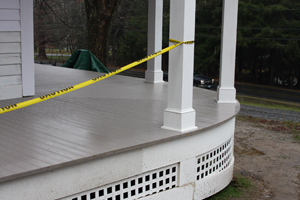Crafting a Curved Exterior Porch Railing
Advice on bending, lamination, wood choice, and details for a curved porch rail. October 13, 2009
Question
I am quoting an exterior colonial porch railing. There are two curved sections with a top rail and a bottom rail, at an 80" radius (photo attached). My thought is to steam, bend, and laminate the rails. Is this the best approach and what species of wood is best for this application? All surfaces will be primed and painted.

Forum Responses
(Architectural Woodworking Forum)
From contributor Z:
Steam bending is hardly needed on such a large radius. Laminate 1/2 strips using Titebond 3 or any other water proof glue. Poplar, pine, cedar, redwood all will hold up fine. We put a peak on our bottom rail and cut birds mouths in the bottom of the ballusters as it sheds water.
From contributor J:
I would certainly use bending rail for stair rails, but I wouldn't bother with it on a horizontal bend like that one.
From contributor M:
Be careful about using poplar. Do a search on this site and you'll get a lot of info about how the poplar readily available today will rot from within in a short time, even when painted extremely well.
From contributor O:
I have witnessed poplar rot in four years on a porch exactly like the one you show.
From the original questioner:
Thanks very much for all of your responses. They are incredibly helpful and I am beginning to get an idea of how to approach this project. Please don't hesitate to provide additional information, experiences as with the poplar related posts, or other thoughts that will raise the quality of this project.
From contributor V:
Iíve had some experience with outside curved railing and it wasnít good using
Titebond. What I would do in the future is laminate strips (mahogany works good) and glue them with fiber resin and then mill them and resin them and prime and paint. Iíve done this and itís bullet proof.
From contributor K:
I made a curved railing like you need to make, (except mine was a full 90 degrees of arc). I used Tite Bond and laminated 1/2" thick strips of white oak. I had a terrible mess when clamping up the assembly, because everything started to slip.
An earlier poster mentioned a means to avoid this slipping problem. Please investigate his recommendation as you might save yourself the huge headache that I had. (PS: Too bad there is a support in the middle of your curve. It ruins the design in every case I have seen it. There have been a number of postings in the past telling how to make a curved cantalevered beam. Next time!)
From contributor B:
I think I would just cut these out of solid stock, shape them and be done with it. No bent lamination's to mess with (and definitely no to poplar and yes to Redwood or Douglas Fir).
From contributor L:
I've done a bunch of these over the years. First, I'd use plastic resin or epoxy to glue the laminations. Second, I'd use honduran mahogany for everything including the balusters (yes I know it's paint grade. I use honduran mahogany for exterior paint grade.) Make the laminations very thin; so thin they'll bend around the radius very easily. Third, I'd prime all end grain prior to final assembly. Two coats is good. This means you prime after you make the saw cut and before you anchor the piece in place. Prime all your bolt holes. Fourth, do your own caulking.
You didn't say what the handrail and bottom shoe rail profiles are supposed to be, but for sure make something that sheds water. Next time I'll use contributor Zís suggestion about the bottom of the baluster and shoe rail joint - great suggestion. If you use the bird's mouth idea, be sure to prime the bottom shoe where the baluster connects. If you can, bend the railing first, plane it to finish size and then run the molding profile on it.
When you clamp up the bend, use blocks clamped above and below the bundle of laminations to keep them all in alignment. The bend will be a snap with nothing sliding around where you don't want it to. Consider contributor B' suggestion to cut it out of solid stock, but if I were doing it, I'd bend. In my opinion band sawing out of solid stock exposes more end grain than bending even though each section only goes 45 degrees of arc it looks like. Lastly, make sure the painter comes back to touch things up every six months for the life of the house. Give the homeowners the usual sermon about how important paint is to the preservation of their nice woodwork.
